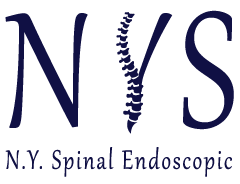If you are looking for relief from pain caused by a herniated disc and low back pain, an endoscopic discectomy could be the answer you need. This is the least-invasive procedure performed in our outpatient surgical facility that removes herniated disc material. Endoscopic spine surgery is considered least-invasive. Least-invasive surgeries (LIS) offer many benefits that traditional spine surgeries do not. Traditional surgeries often require long recovery times and have high infection and morbidity rates. LIS decreases the risks involved with surgery, reduces recovery time, and returns most patient to work within two to three weeks. It’s important to talk to your doctor about the benefits and risks of endoscopic spine surgery to determine if it’s the right choice for you.
Endoscopic discectomy is different from open or MIS lumbar microdiscectomy. In our endoscopic spine surgery, there is no muscle dissection, no removal of the bone, and we don’t need to make a large incision in your skin. Because of that, there is less risk of scarring, infection, blood loss, or complications from anesthesia. Endoscopic discectomy was invented as a least-invasive interventional pain management procedure that effectively treats herniated discs while lowering the risks involved with traditional surgeries.
The advantage of an endoscopic spine procedure is that your surgeon only needs to make a ¼ inch incision. That means the muscles of the middle of your back are spared, which results in less recovery time and fewer risks for complications.
HOW IS THE PROCEDURE PERFORMED?
You’ll be given a local anesthetic so you don’t feel anything during the surgery. Once you’ve been numbed, an incision will be made near the herniated disc and through muscle tissue in your back. A dilator is inserted to keep the incision open with a 1/4 inch metal tube giving the surgeon access to the disc. An HD camera/endoscope is inserted so the surgeon can clearly see the herniated disc and make an evaluation of what needs to be removed. Microscopic instruments are inserted through the endoscope to remove the herniated disc. Inside of the disc, any tears are cleaned and treated with a laser to ablate the nerves that are growing in the tear of the annular layer of the disc. The laser shrinks and closes the tears while keeping the disc intact. Once the treatment is complete with any tears sealed and herniated discs removed, the metal tube is taken out and the surgeon will close the incision.
ADVANTAGES OF ENDOSCOPIC DISCECTOMY INCLUDE:
- 90% or higher success rates
- HD cameras are used to give the surgeon a better view of the damage in the area
- No spinal fusion is necessary
- Minimal incision size of just 1/4 inch reduces the risk of scarring
- Spinal mobility is preserved because there is less scarring and tearing of muscle tissue
- Less risk for large amount of blood loss
- Conscious sedation means there is no need for general anesthesia
- Less recovery time
- Less pain during recovery means less dependence on narcotic pain medication
- You can resume normal activities sooner!
WHAT IS THE ENDOSCOPIC DISCECTOMY SUCCESS RATE?
Published follow-up studies and our in-house observations show that endoscopic discectomy surgery is a highly successful procedure. A study that observed the post-surgical condition of patients over a 10-year period showed that more than 80 percent reported excellent results and none had any poor results.
WHAT IS THE ENDOSCOPIC DISCECTOMY RECOVERY TIME?
The time of recovery for the endoscopic discectomy procedure depends on the type of work you do.
For people who do office work and other kinds of sedentary jobs, the time of recovery is usually one to two weeks. For more active people, like athletes and those who move around more often during their regular workday, the time of recovery may be four to six weeks.
During the recovery period, you’ll need to participate actively in a physical therapy program. Physical therapy will help you recover and return to your regular activities faster. Some patients may also be required to take pain relievers during the recovery period.
HOW LONG IS THE RECOVERY AND HOW SOON CAN YOU RETURN TO WORK?
An endoscopic discectomy takes about an hour. You shouldn’t experience a great deal of pain afterward but may feel a little sore. You don’t even have to worry about stitches; your incision will simply be covered with a band-aid. It takes about an hour to recover from the procedure in our outpatient surgical facility and then you can go home. After that, you’ll need to see how your body responds to the surgery. Most patients feel better right away and can return to work in a couple days. It’s important to listen to your body and discuss your symptoms with your doctor to ensure you are ready to resume normal activities. Avoid heavy lifting until your doctor gives you the okay, even if you feel fine.
